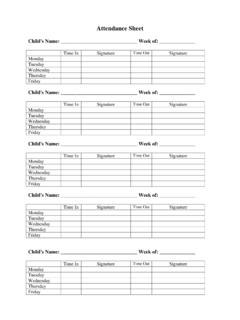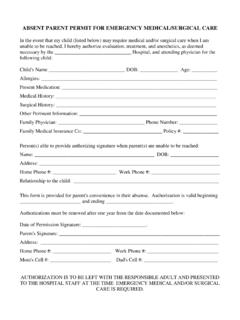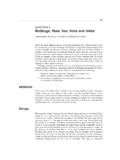Transcription of Dear Parents, - daycareanswers.com
1 Dear Parents, A case of head lice has been discovered on a child who attends my daycare. Be assured that we will be doing everything possible to prevent the spread of the lice to other children in care. Please note that although head lice are annoying, they do not pose a health threat to your child(ren). There are a lot of myths about head lice that I'd like to clarify. head lice are not a disease, and present NO health danger. They do cause itching, but do not carry disease. Getting lice does not mean you're dirty. lice do not care if your head is clean, dirty, oily, dry, short hair, long hair, young or old. They just crawl to the nearest warm head. And actually, lice are more attracted to clean hair that is not oily and slippery. head lice can not jump or fly. They can only crawl from head to head. Following is a list of facts you may find helpful: 1. lice are tiny bugs that live on the scalp of humans.
2 They attach their eggs to a person s hair with a sticky, glue-like substance. 2. lice are spread through close, direct physical contact with an infected person. Items such as shared combs, hats, upholstery, jackets, clothing and other items that have come into contact with infested hair can also spread lice . Children should NEVER share these items with other children. 3. The bug is hard to see and nits (eggs) are usually found upon inspection. An adult louse lays about ten eggs per day for seven days. The eggs hatch in ten (10) days. 4. A female Louse lives for 30 days 5. Nits take 7-10 days to hatch 6. Nymphs take another 10-12 days to become adults ready to lay eggs. 7. Viable nits are brownish/yellow in color 8. Hatched nits are clear or opaque never white 9. Nits are glued to the hair at an angle and look like a teardrop 10. Once off a human head, adult lice can only live a maximum of 48 hours and baby lice (nymphs) can only survive a couple of hours.
3 11. Nit hot spots: behind the ears, crown of head, forehead hairline, nape of neck. 12. The first signs of lice infestation you may notice are itching, irritation and redness of the skin or scalp area. The actual infestation usually begins 30 35 days before any of these signs appear. 13. Transmission of head lice from inanimate objects (the environment) is very uncommon. WHAT YOU SHOULD DO: 1. Check your children s head daily if lice are present in daycare. 2. If your child has lice : Begin treatment immediately. Contact your primary caregiver for a recommendation. It is essential to continue searching for nits with your fingers, a fine toothed comb or a special nit comb for several days after the last lice sighting. Check all family members on a regular basis. Wash or dry clean all items that would have touched the hair or scalp. Thoroughly vacuum stuffed furniture and carpeting.
4 Anything that cannot be washed, dry cleaned, or vacuumed, , stuffed toys, hats, etc. should be sealed in a plastic bag for ten (10) days. Wash your hands after every contact with infected hair. WHAT I WILL DO: 1. All of the above, and 2. Exclude all children who have lice . 3. Check all children's heads daily. This will continue for ten (10) days after the last sighting of lice . 4. Practice careful hand washing after every single head check. WHEN CAN A CHILD RETURN TO DAYCARE AFTER A lice INFESTATION? As soon as the treatment has been completed and no lice , nits/eggs can be found after an inspection by the parent and an inspection by the provider upon arrival at daycare. Thank you for your cooperation.






